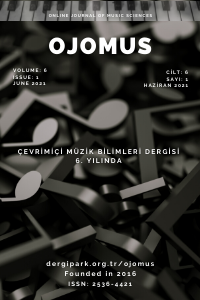METAFOR YÖNTEMİYLE ÇALIŞILMIŞ MÜZİK MAKALELERİNDEKİ GENEL EĞİLİM
Bu çalışmada, güncel haliyle metafor yöntemiyle çalışılmış 35 adet Türkçe müzik makalesi bulunmaktadır. Metafor yöntemiyle veri elde etme, başka disiplinlerde kullanılagelen bir yöntem olmasına karşın müzik alanındaki kullanımı oldukça geç başlamıştır. Araştırmalar sonucunda, Türkiye’de müzik alanında metafor yöntemi ile gerçekleştirilen ilk çalışma 2013 yılında yapılmış ve bu yöntemin kullanımı zamanla yaygınlaşmıştır. Mevcut çalışma, müzik alanı için yeni sayılabilecek bu yöntemin kullanılış esaslarını tanıtarak kullanımdaki genel eğilimi göstermektedir. Türk müzik veri toplamanın araştırması için uygun olabileceğini düşünen yeni araştırmacılara bir yön gösterici olacaktır. İncelenen makalelerde, bağlamın fenomenolojik desen ile oluşturulduğu görülmektedir. Müzik araştırmacıları “ses, müzik, çalgı” gibi olguların hedef kitleleri tarafından nasıl algılandığını metaforlar aracılığıyla betimlemişlerdir. Çalışmalar; olgular, çalışma grupları, yıl, kapsam, işlem basamakları, yayınlandıkları dergilerin özellikleri ve kullanılan kaynaklar bakımından incelenmiştir. Yapılan sentez sonuçları, yıllar içinde konu ve yönteme olan eğilimin yönünü ve bu çalışmaların birbiriyle olan bağını göstermektedir.
Anahtar Kelimeler:
Müzik, metafor yöntemi, mecaz, olgu, fenomenoloji.
GENERAL TENDENCY IN MUSIC ARTICLES STUDIES DONE WITH METAPHOR METHOD
There are currently 35 Turkish articles about music, which are on research done with the metaphor method. Obtaining data with metaphor, although it is commonly used in other disciplines, in the field of music has been quite late. As can be seen, the first metaphor method study in the field of music in Turkey was carried out in 2013 and the use of the method has become widespread over time. The present study introduces the principles of the use of this method, which can be considered new for the field of music, and shows the general trend in use. This study, which includes the synthesis of Turkish music researchers' metaphor research use behavior and situations, will be a practical direction for new researchers that think that data collection with this method may be appropriate for their research. In the articles examined, it is seen that the context is created with a phenomenological pattern. Music researchers describe how phenomena such as “sound, music, instrument” are perceived by their target audiences through metaphors. Studies; cases, study groups, year, scope, process steps, features of the journals in which they were published, and sources used. The results made shows the direction of the trend toward the subject and method over the years and the interconnection of these studies.
Keywords:
Music, metaphor method, figure of speech, phenomenon, phenomenology.,
___
- Aydın, İ. H. (2006). Bir felsefi metafor “yolda olmak”. Dinbilimleri Akademik Araştırma Dergisi, 6 (4), 10. dergipark.org.tr/tr/pub/daad/issue/4509/62074
- Black, M. (1979). More about metaphor. Metaphor and thought, 2, 19-41.
- Erkuş, A. (2021). Davranış bilimleri için bilimsel araştırma süreci. Seçkin Yayıncılık.
- Gibbs, R. W. (1999). Researching metaphor. Researching and applying metaphor, 29-47.
- Jensen, L. X., Bearman, M., & Boud, D. (2021). Understanding feedback in online learning–A critical review and metaphor analysis. Computers & Education, 173, 104271.
- Kılcan, B. (2017). Metafor ve eğitimde metaforik çalışmalar için bir uygulama rehberi. Pegem Akademi.
- Kovecses, Z. (2010). Metaphor: A practical introduction. Oxford university press.
- Lakoff, G. (1993). The contemporary theory of metaphor.
- Lakoff, G. ve Johnson, M. (2005). Metaforlar hayat, anlam ve dil. Paradigma Yayınları.
- Northcote, M. & Fetherston, T. (2006). New Metaphors for Teaching and Learning in a University Context. Proceedings of the 29 th Herdsa Annual Conference (s. 251-258). Perth, Western Australia: Higher Education Research and Development Society of Australasia.
- Online Etymology Dictionary, (2022, Kasım 29). Metafor nedir? https://www.etymonline.com/search?q=metaphor
- Ortony, A. E. (1993). Metaphor and thought. Cambridge University Press.
- Saban, A. (2008). Okula ilişkin metaforlar. Kuram ve Uygulamada Eğitim Yönetimi. 14(55), 459- 496. https://dergipark.org.tr/tr/pub/kuey/issue/10342/126702
- Yıldırım, A. ve Şimşek, H. (2008). Sosyal bilimlerde nitel araştırma yöntemleri. Ankara: Seçkin
- ISSN: 2536-4421
- Yayın Aralığı: Yılda 2 Sayı
- Yayıncı: Nilgün SAZAK
Sayıdaki Diğer Makaleler
ÇOK KANALLI SES MİKSAJINDA REVERB KULLANIMI
METAFOR YÖNTEMİYLE ÇALIŞILMIŞ MÜZİK MAKALELERİNDEKİ GENEL EĞİLİM
ARMONİ EĞİTİMİNDE HİCAZ MAKAM DİZİSİ KULLANIMININ ÖĞRENCİ BAŞARISINA ETKİSİ
Hacı Bekir KURŞUNET, Sena OTACIOĞLU
FARKLI MÜZİK TÜRLERİNDE CÜMBÜŞ ÇALGISI VE İCRACILARI
YAYLI ÇALGI EĞİTİMİNDE BİRDEN ÇOK EĞİTİMCİYLE ÇALIŞMANIN ÖĞRENCİLER ÜZERİNDEKİ ETKİSİ
Ümit Başar KAMERLİ, Sadık YÖNDEM
AHMET ADNAN SAYGUN’UN “GENÇLİĞE ŞARKILAR” KİTABINDAKİ ESERLERİN FORM YAPILARI
Mûsikîde Batılılaşma: Muallim İsmail Hakkı Bey ve Bülbül Opereti
